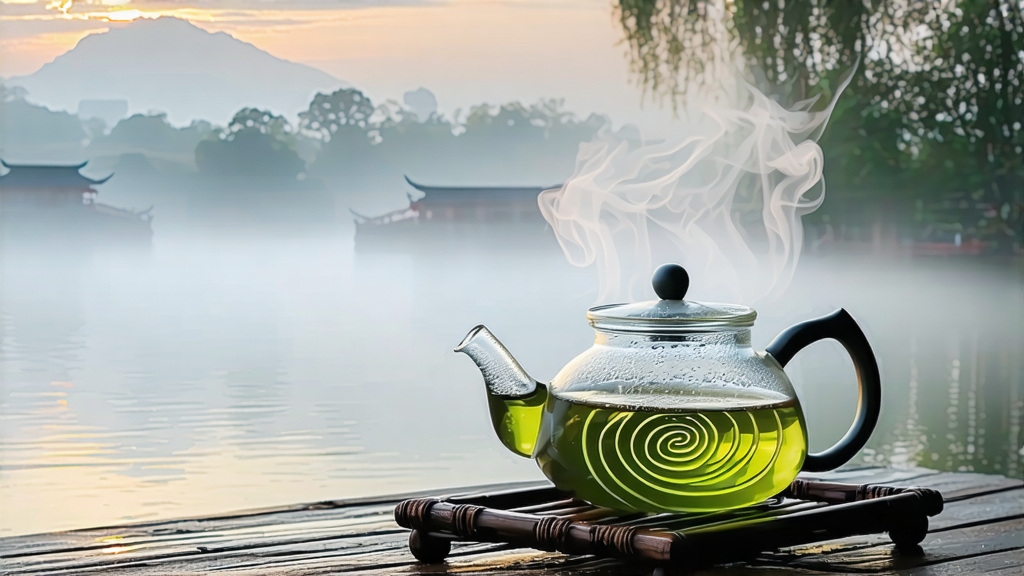
Among the ten most celebrated Chinese green teas, none carries a name as whimsical yet precise as Biluochun—literally “Green Snail Spring.” The tiny, tightly curled leaves resemble the spiral shell of a river snail, plucked in the season when spring is still shy and the lake mists cling to mountain slopes. To international drinkers accustomed to the flat blades of Longjing or the needle elegance of Huangshan Maofeng, Biluochun offers a different grammar of beauty: a miniature scroll of jade that unfurls in hot water to release an aroma more reminiscent of white-fleshed peaches and wild orchids than of the vegetal bite often expected from green tea. Understanding this tea is to listen to three intertwined stories—geology, botany, and human ingenuity—played out on the islands and peninsulas of East China’s Lake Tai near the city of Suzhou.
Historical whispers place Biluochun’s birth during the late Ming dynasty, around the seventeenth century. Local chronicles speak of a nun who wandered the Dongting hills, gathering wild tea shoots for meditation brews. The infusion so startled visiting merchants with its fragrance that they asked for the name; the nun, glancing at the conical hill shaped like a snail shell, replied “Xia Sha Ren Xiang” (“Scary-fragrant”). Commerce soon polished the moniker into the more elegant “Biluochun,” and the Kangxi Emperor, on his southern inspection tour of 1699, is said to have renamed it officially after the Bi (“green”) Luo (“snail”) shape and the chun (“spring”) harvest. Whatever the legend’s accuracy, imperial favor catapulted the tea into tribute status, and by the nineteenth century European export records list “Pi-lo-chun” among the costliest Chinese leaf teas sold in London and St Petersburg.
Today the appellation “Biluochun” is protected under China’s GI (Geographical Indication) system. Only leaf picked within the Dongting Mountains of Wuzhong District, Suzhou, may bear the name, much like Champagne in France. Within this micro-zone two ecotypes dominate: the original “Xiao Ye” (small-leaf) cultivar that grows on tree-like bushes scattered among fruit orchards, and the modern clonal “Dongting #1” selected for higher yield yet still required to maintain the chemotype that yields the tea’s signature fruity lactones. The small-leaf strain, rarely above two centimeters when mature, is lower in tannins but richer in aromatic precursors, explaining why old-garden Biluochun can steep three times without astringency while exuding nectarine notes.
The crafting choreography that turns a fragile bud-and-leaf pair into an enduring spiral has changed little since the Qing. Picking begins when two and a half leaves unfold from the apical bud—what locals call “the sparrow’s tongue” stage—typically between the Qingming and Grain Rain solar terms (early April). Each kilo of finished tea needs roughly sixty to seventy thousand of these shoots, all plucked before ten in the morning when dew still shields the cell walls from bruising. The first craft step is “qing dui” (light withering), spreading the harvest no thicker than three centimeters on bamboo trays set in the shade of peach and plum trees. The fruit pollen drifting in the breeze is not mere poetry; laboratory analysis shows elevated β-ionone and linalool oxides in leaf picked within orchards, confirming centuries of folk wisdom that co-cultivation shapes flavor.
Withering lasts only thirty to forty minutes, just long enough for the grassy aldehydes to volatilize and for the moisture content to drop from 76 % to around 70 %. Next comes “shaqing,” the kill-green fixation. Unlike the wok-firing spectacle of Longjing, Biluochun is fixed in a shallow, waist-high drum heated to 180 °C. The craftsperson tosses 250 g batches for precisely three minutes, using wrist flicks that toss the leaf skyward so each shoot contacts oxygen and heat evenly. The goal is to halt oxidative enzymes while preserving the hydroxy fatty acids that later yield the tea’s honeyed finish. Immediately after fixation the leaf is still too hot to touch; veterans judge readiness by ear, listening for the crackle that sounds “like sesame seeds dancing on porcelain.”
While the leaf cools, the most iconic step—spiraling—begins